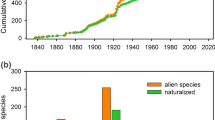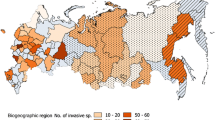Abstract
Invasive non-native species (invasive species, henceforth) across all taxonomic groups are spreading globally, with numbers projected to continue growing in the future. It is difficult for governments and managers to handle this issue when the identity of invasive species or the areas of occurrence of biological invasions are not known. Here, we provide an updated list of invasive animals, plants and algae in Brazil that is fully integrated and based on the same criteria and lexicon to define invasive species across all plant and animal taxa and habitats. We list 444 invasive non-native species: 254 animals, 188 plants and 2 algae. Some of the invasive species have been present in Brazil since the beginning of the European colonization in the 1500 s, but the majority of first records in Brazil were made in the last century, with copious first records after the year 2000. The list of invasive species presented here represents the most comprehensive attempt thus far to catalog all invasive non-native species at a continental-scale for a megadiverse country. Brazil has published a national strategy with the objective of improving mechanisms and partnerships for invasive non-native species prevention, early detection and rapid response. We believe that the current list of invasive species will provide technical and scientific support for the implementation of effective measures in the management of biological invasions.



Similar content being viewed by others
References
Adelino R, Heringer G, Diagne C et al (2021) The economic costs of biological invasions in Brazil: a first assessment. NeoBiota 67:349–374. https://doi.org/10.3897/neobiota.67.59185
Bacher S, Galil BS, Nuñez MA et al (2023). Chapter 4: Impacts of invasive alien species on nature, nature's contributions to people, and good quality of life. In: Thematic Assessment Report on Invasive Alien Species and their Control of the Intergovernmental Science-Policy Platform on Biodiversity and Ecosystem Services. Roy HE, Pauchard A, Stoett P et al (eds.). IPBES secretariat, Bonn, Germany. https://doi.org/10.5281/zenodo.7430731
Bernery C, Bellard C, Courchamp F et al (2022) Freshwater fish invasions: a comprehensive review. Annu Rev Ecol Evol Syst 53:427–456. https://doi.org/10.1146/annurev-ecolsys-032522-015551
Borokini IT, Kortz A, Anibaba QA et al (2023) Alien flora of Nigeria: taxonomy, biogeography, habitats, and ecological impacts. Biol Invasions 25:3677–3696. https://doi.org/10.1007/s10530-023-03140-1
Bueno ML, Magalhães ALB, Andrade Neto FR et al (2021) Alien fish fauna of southeastern Brazil: species status, introduction pathways, distribution and impacts. Biol Invasions. https://doi.org/10.1007/s10530-021-02564-x
de Frehse F, A, Braga RR, Nocera GA, Vitule JRS, (2016) Non-native species and invasion biology in a megadiverse country: scientometric analysis and ecological interactions in Brazil. Biol Invasions 18:3713–3725. https://doi.org/10.1007/s10530-016-1260-9
Dechoum MDS, Junqueira ADOR, Orsi ML (eds) (2024) Relatório Temático sobre Espécies Exóticas Invasoras, Biodiversidade e Serviços Ecossistêmicos. 1a edição, São Carlos: Editora Cubo. 293 páginas. https://doi.org/10.4322/978-65-00-87228-6
Espínola LA, Rabuffetti AP, Carrara N et al (2022) Increased geographical distribution and richness of non-native freshwater fish species in Argentina: evidence from a literature review. Biol Invasions 24:1611–1634. https://doi.org/10.1007/s10530-022-02742-5
Gulzar R, Wani SA, Hassan T et al (2023) Looking beyond the political boundaries: an integrated inventory of invasive alien flora of South Asia. Biol Invasions. https://doi.org/10.1007/s10530-023-03165-6
Hao Q, Ma J-S (2023) Invasive alien plants in China: An update. Plant Diversity 45:117–121. https://doi.org/10.1016/j.pld.2022.11.004
Instituto Hórus de Desenvolvimento e Conservação Ambiental (2023) Base de Dados Nacional de Espécies Exóticas Invasoras
Hulme PE, Ikeda T, Vandvik V et al (2023). Chapter 3: Drivers affecting biological invasions. In: Thematic Assessment Report on Invasive Alien Species and their Control of the Intergovernmental Science-Policy Platform on Biodiversity and Ecosystem Services. Roy HE, Pauchard A, Stoett P et al (eds.). IPBES secretariat, Bonn, Germany. https://doi.org/10.5281/zenodo.7430727
IPBES (2019) Global assessment report on biodiversity and ecosystem services of the Intergovernmental Science-Policy Platform on Biodiversity and Ecosystem Services. Brondizio ES, Settele J, Díaz S et al (editors). IPBES secretariat, Bonn, Germany. 1148 pages. https://doi.org/10.5281/zenodo.3831673
Júlio-Júnior HF, Tós CD, Agostinho ÂA, Pavanelli CS (2009) A massive invasion of fish species after eliminating a natural barrier in the upper rio Paraná basin. Neotrop Ichthyol 7:709–718. https://doi.org/10.1590/S1679-62252009000400021
Magliozzi C, Tsiamis K, Vigiak O et al (2020) Assessing invasive alien species in European catchments: distribution and impacts. Sci Total Environ 732:138677. https://doi.org/10.1016/j.scitotenv.2020.138677
R Core Team (2022) R: A Language and Environment for Statistical Computing
Rosa CA, Curi NH de A, Puertas F, Passamani M (2017) Alien terrestrial mammals in Brazil: current status and management. Biological Invasions 19:2101–2123. https://doi.org/10.1007/s10530-017-1423-3
Roy HE, Pauchard A, Stoett P, et al (2024) IPBES Invasive Alien Species Assessment: Summary for Policymakers. URL https://zenodo.org/doi/10.5281/zenodo.7430692
Sampaio AB, Schmidt IB (2014) Espécies exóticas invasoras em unidades de conservação federais do Brasil. Biodiversidade Brasileira 3:32–49
Sankaran K, Schwindt E, Sheppard AW, et al (2023) IPBES Invasive Alien Species Assessment: Chapter 5. Management; challenges, opportunities and lessons learned. In: Thematic Assessment Report on Invasive Alien Species and their Control of the Intergovernmental Science-Policy Platform on Biodiversity and Ecosystem Services. Roy HE, Pauchard A, Stoett P et al (eds.). IPBES secretariat, Bonn, Germany. https://doi.org/10.5281/zenodo.7430733
GBIF Secretariat (2023) GBIF Backbone Taxonomy
Seebens H, Meyerson LA, Rahlao SJ, et al (2023) IPBES Invasive Alien Species Assessment: Chapter 2. Trends and status of alien and invasive alien species. Zenodo
Teixeira L, Creed J (2020) A decade on: an updated assessment of the status of marine non-indigenous species in Brazil. AI 15:30–43. https://doi.org/10.3391/ai.2020.15.1.03
Turbelin AJ, Malamud BD, Francis RA (2017) Mapping the global state of invasive alien species: patterns of invasion and policy responses: mapping the global state of invasive alien species. Global Ecol Biogeogr 26:78–92. https://doi.org/10.1111/geb.12517
Vinogradova Y, Pergl J, Essl F et al (2018) Invasive alien plants of Russia: insights from regional inventories. Biol Invasions 20:1931–1943. https://doi.org/10.1007/s10530-018-1686-3
Vitule JRS, Occhi TVT, Kang B et al (2019) Intra-country introductions unraveling global hotspots of alien fish species. Biodivers Conserv 28:3037–3043. https://doi.org/10.1007/s10531-019-01815-7
Zappi DC, Filardi FLR, Leitman P et al (2015) Growing knowledge: an overview of seed plant diversity in Brazil. Rodriguésia 66:1085–1113. https://doi.org/10.1590/2175-7860201566411
Zenni RD (2014) Analysis of introduction history of invasive plants in Brazil reveals patterns of association between biogeographical origin and reason for introduction. Austral Ecol 39:401–407. https://doi.org/10.1111/aec.12097
Zenni RD (2015) The naturalized flora of Brazil: a step towards identifying future invasive non-native species. Rodriguésia 66:1137–1144. https://doi.org/10.1590/2175-7860201566413
Zenni RD, de DechoumZiller MSSR (2016) Dez anos do informe brasileiro sobre espécies exóticas invasoras: avanços, lacunas e direções futuras. Biotemas 29:133. https://doi.org/10.5007/2175-7925.2016v29n1p133
Zenni RD, Ziller SR (2011) An overview of invasive plants in Brazil. Braz J Botany 34:431–446. https://doi.org/10.1590/S0100-84042011000300016
Ziller SR, de Dechoum MS (2013) Plantas e vertebrados exóticos invasores em unidades de conservação no Brasil. Biodiversidade Brasileira 3:4–31
Acknowledgements
The activities that led to this publication are in the scope of the National Strategy on Invasive Alien Species and were funded by the Global Environment Facility (GEF) through Project 029840—National Strategy for the Conservation of Threatened Species—Pro-Species: All against extinction. The Pro-Species Project is coordinated by the Ministry of the Environment; the Brazilian Biodiversity Fund (FUNBIO) is the implementing agency, and WWF-Brazil is the executing agency.
The ideas and opinions expressed in this work are the sole responsibility of the author(s) and do not necessarily reflect the opinions of the Pro-Species Project and the Coordination Council (MMA, Funbio and WWF-Brazil). We are extremely thankful to all researchers and professionals in environmental areas who contributed to the review and validations of the invasive non-native species list. GH thanks Coordenação de Aperfeiçoamento de Pessoal de Nível Superior—Brasil (Capes)—Finance code 001 and Alexander von Humboldt Foundation for supporting his postdoctoral research.
Funding
The activities that led to this publication are in the scope of the National Strategy on Invasive Alien Species and were funded by the Global Environment Facility (GEF) through Project 029840—National Strategy for the Conservation of Threatened Species—Pro-Species: All against extinction. The Pro-Species Project is coordinated by the Ministry of the Environment; the Brazilian Biodiversity Fund (FUNBIO) is the implementing agency, and WWF-Brazil is the executing agency.
Coordenação de Aperfeiçoamento de Pessoal de Nível Superior—Brasil (Capes)—Finance code 001 provided scholarships for Gustavo Heringer, Ana Carolina L. de Matos, Marina L. Bueno, and Jonathan W. Almeida.
Alexander von Humboldt Foundation provided a scholarship for Gustavo Heringer.
Author information
Authors and Affiliations
Contributions
RDZ, SRZ, CADR, RBS, PBP, BTPM, CHTS, JRL-J, and TEC contributed to the study conception and design. Material preparation and data collection were performed by RDZ, SRZ, CADR, RBS, PBP, BTPM, GH, ACLDM, MLB, and JWA. Analysis was performed by RDZ and revised by GH. The first draft of the manuscript was written by RDZ and all authors commented on previous versions of the manuscript. All authors read and approved the final manuscript.
Corresponding author
Ethics declarations
Conflict of interest
The authors have no relevant financial or non-financial interests to disclose.
Additional information
Publisher's Note
Springer Nature remains neutral with regard to jurisdictional claims in published maps and institutional affiliations.
Supplementary Information
Below is the link to the electronic supplementary material.
Rights and permissions
Springer Nature or its licensor (e.g. a society or other partner) holds exclusive rights to this article under a publishing agreement with the author(s) or other rightsholder(s); author self-archiving of the accepted manuscript version of this article is solely governed by the terms of such publishing agreement and applicable law.
About this article
Cite this article
Zenni, R.D., Ziller, S.R., da Rosa, C.A. et al. Invasive non-native species in Brazil: an updated overview. Biol Invasions (2024). https://doi.org/10.1007/s10530-024-03302-9
Received:
Accepted:
Published:
DOI: https://doi.org/10.1007/s10530-024-03302-9




